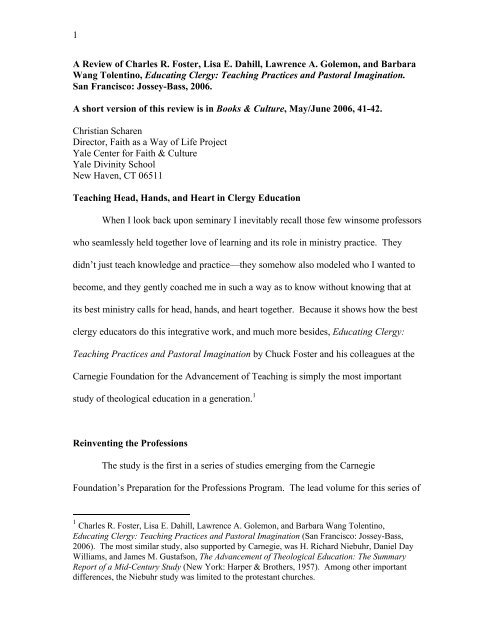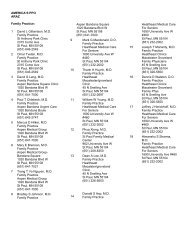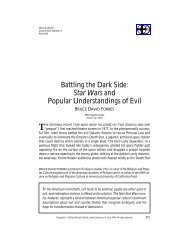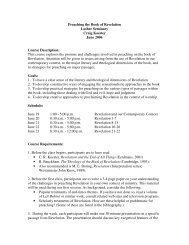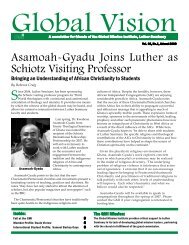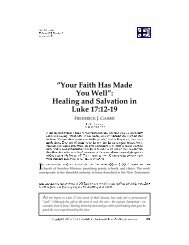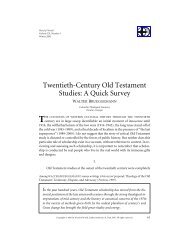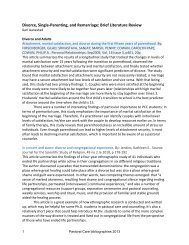Educating Clergy - Luther Seminary
Educating Clergy - Luther Seminary
Educating Clergy - Luther Seminary
- No tags were found...
Create successful ePaper yourself
Turn your PDF publications into a flip-book with our unique Google optimized e-Paper software.
1A Review of Charles R. Foster, Lisa E. Dahill, Lawrence A. Golemon, and BarbaraWang Tolentino, <strong>Educating</strong> <strong>Clergy</strong>: Teaching Practices and Pastoral Imagination.San Francisco: Jossey-Bass, 2006.A short version of this review is in Books & Culture, May/June 2006, 41-42.Christian ScharenDirector, Faith as a Way of Life ProjectYale Center for Faith & CultureYale Divinity SchoolNew Haven, CT 06511Teaching Head, Hands, and Heart in <strong>Clergy</strong> EducationWhen I look back upon seminary I inevitably recall those few winsome professorswho seamlessly held together love of learning and its role in ministry practice. Theydidn’t just teach knowledge and practice—they somehow also modeled who I wanted tobecome, and they gently coached me in such a way as to know without knowing that atits best ministry calls for head, hands, and heart together. Because it shows how the bestclergy educators do this integrative work, and much more besides, <strong>Educating</strong> <strong>Clergy</strong>:Teaching Practices and Pastoral Imagination by Chuck Foster and his colleagues at theCarnegie Foundation for the Advancement of Teaching is simply the most importantstudy of theological education in a generation. 1Reinventing the ProfessionsThe study is the first in a series of studies emerging from the CarnegieFoundation’s Preparation for the Professions Program. The lead volume for this series of1 Charles R. Foster, Lisa E. Dahill, Lawrence A. Golemon, and Barbara Wang Tolentino,<strong>Educating</strong> <strong>Clergy</strong>: Teaching Practices and Pastoral Imagination (San Francisco: Jossey-Bass,2006). The most similar study, also supported by Carnegie, was H. Richard Niebuhr, Daniel DayWilliams, and James M. Gustafson, The Advancement of Theological Education: The SummaryReport of a Mid-Century Study (New York: Harper & Brothers, 1957). Among other importantdifferences, the Niebuhr study was limited to the protestant churches.
2studies is titled Work and Integrity. There, Program Director William Sullivan divulgesthe Foundation’s root concern driving the program as a whole. Sullivan argues that theprofessions are impoverished today because of the rise of a kind of “technicalprofessionalism” that has lost its mooring from a normative orientation to the broaderpublic good. 2The movement in the eighteenth century from apprenticeship training to trainingin the university is the most salient factor in the rise of this sort of “technicalprofessionalism,” according to Sullivan. Whereas in the apprenticeship model, thedominant method for training was face-to-face time with expert practitioners, with therise of university training in the professions a separation developed between the formalanalyticparts and the clinical and practical parts of the curriculum. Sullivan argues thatover time the positivist cast of the university has instituted a hierarchy of priority amongwhat he calls “the three apprenticeships”: first priority (usually with the most prestigioustenure positions) is the cognitive apprenticeship, followed by the skill apprenticeship(often taught by adjunct faculty) with the third apprenticeship—normative or professionalidentity—left to ad hoc influence of particular faculty or workplace mentors. Thelynchpin of his argument—and the reason for Carnegie’s keen interest in clergyeducation—lies in the revitalization of the professions. <strong>Clergy</strong> education, by combiningprofessional and vocational formation, most clearly offers to the other professions a vital2 William M. Sullivan, Work and Integrity: The Crisis and Promise of Professionalism inAmerica, Second Edition (San Francisco: Jossey-Bass, 2005), 9. Many readers will hear echoesof Sullivan’s prior work as a co-author of Habits of the Heart that decried a gradual uncouplingof career from calling and civic commitment, leaving technical expertise in the service ofbureaucratic rules on the one hand or individual success on the other. Robert N. Bellah, RichardMadsen, William M. Sullivan, Ann Swidler, and Steven M. Tipton, Habits of the Heart:Individualism and Commitment in American Life (Berkeley: The University of California Press,1985), 119 and passim.
3image of the third apprenticeship as a means to give moral shape and an organizingcenter to professional knowledge and practice. 3Showing and Telling Excellence in <strong>Clergy</strong> EducationGiven this interest on the part of the Carnegie Foundation, it is not surprising thatof the planned studies of engineering, law, medicine, nursing and clergy, the clergy studywas completed first. Led by Charles R. Foster, a well-known figure in the field ofChristian Religious Education and emeritus professor of religion and education at EmoryUniversity, and fellow researchers Lisa E. Dahill, Lawrence A. Golemon, and BarbaraWang Tolentino, the clergy study focused on teaching practices at accredited seminariesfrom various Christian and Jewish traditions. The research team spent three years inpursuit of this core research question: “How do seminary educators foster among theirstudents a pastoral, priestly, or rabbinic imagination that integrates knowledge and skill,moral integrity, and religious commitment in the roles, relationships, and responsibilitiesthey will be assuming in clergy practice?” 4In addition to tending carefully to a wide range of relevant literature and makinggood use of survey instruments, the research team visited ten seminaries in order tointerview faculty, students, and administrators, observe classes, and participate in the lifeof the community (albeit for a very brief window of time—usually two to three days).Choosing “appreciative inquiry” as a methodology emphasizes what is already workingand then seeks to influence change through amplifying these aspects. Thus when theyapproached 18 seminaries (representing Conservative and Reform Jewish, as well as3 Sullivan, Work and Integrity, 217ff.4 Foster, et. al., <strong>Educating</strong> <strong>Clergy</strong>,13.
4Catholic, Orthodox and Protestant Christian schools) they explicitly requested names offaculty who were known for excellence in integrative teaching for ministry. Creativeexamples of a representative sampling of these teachers are peppered throughout thebook.In introducing the study at the American Academy of Religion meetings in 2005,Charles Foster noted that this study offers a number of firsts including the firstcomprehensive study of how seminaries educate and the first to attend to the varieties ofways seminaries educate—from classroom teaching to a seminary’s culture in thebroadest sense, as well as community worship and formation, field education, and allmanner of small group and individual vocational reflection processes. With breadth offocus reminiscent of Being There, an influential ethnographic study of two Protestantseminaries and the formative power of their respective cultures 5 , Foster et. al. wantedboth to explore the relationship between teacher’s intentions and actual practices as wellas the relationship between the in-class teaching and the communal formation beyond theclassroom. The broad scope gives the book a sophistication and depth unparalleled in theliterature.Despite its ambitious aim and scope, <strong>Educating</strong> <strong>Clergy</strong> has an elegant and simplelogic to carry the reader along, unquestionably rewarding the reader with rich details andprofound insights along the way. The book is set out in four parts.The book begins with an extended exegesis of two terms in the subtitle: teachingpractices and pastoral imagination. Pastoral imagination, a term borrowed from LillyEndowment’s Vice President for Religion, Craig Dykstra, offers a way to speak about an5 Jackson W. Carroll, Barbara G. Wheeler, Daniel O. Aleshire, and Penny Long Marler, BeingThere: Culture and Formation in Two Theological Schools (New York: Oxford University Press,1997).
5integrative and improvisational capacity—“a way of seeing into and interpreting theworld”—at the heart of excellent pastoral, priestly, or rabbinic ministry. If cultivatingthis sort of imagination is the aim, Foster and company argue, then the means to achieveit lie in a notion of practice, and especially a community of practice where newperspectives, skills, habits and values develop in the context of others who share commoncommitments. 6 While proposing that theological educators largely share the goal ofcultivating excellence for ministry, they carry out this work through a quite diverse set ofpedagogical practices, both in the classroom and beyond. Yet in the midst of thisdiversity, a common framework consisting of pedagogies of interpretation, formation,contextualization, and performance seems nearly universal. They call this four-foldpattern a signature pedagogical framework—in spite of the diversity—these fourintentions are so persistently present as to be considered distinctive to teaching seminarystudents.To give greater depth, Foster et. al. take up this signature framework of fourpedagogies, spending one chapter elaborating each via vibrant examples drawn fromvarious schools participating in the study. They not only attend to how differences ofsubject matter influence teaching but also highlight here the influence of seminary cultureand tradition, a topic interwoven throughout but receiving explicit focus towards thelatter part of the book. The authors focus on practices of interpretation, formation,contextualization, and performance in clergy roles and ways of thinking, doing, and6 While they draw on familiar figures here for the most part—including Alasdair MacIntyre andPierre Bourdieu—they introduce and then make strong use of Jean Lave and Etienne Wenger whohave done very important work on apprenticeship and the notion of a community of practice. Seeespecially Etienne Wenger, Communities of Practice: Learning, Meaning, and Identity (NewYork: Cambridge University Press, 1998).
6being. In addition, they aim from the beginning to show that the best teachers draw onmultiple modes within one class.Such teaching in class is essential and yet they rightly understand that much ofwhat is taught in seminary comes from the school’s culture and extracurricular influencesand so the authors carefully attend to the educational formation that happens beyond theclassroom, as well. To do this, Foster et. al. detail the history and contemporaryinfluence of five traditions in seminary education and give sketches of historical figurescentral to each: Timothy Dwight, president at Yale and founder of the Protestantfreestanding seminary; Emma Dryer, cofounder of the Moody Bible Institute andinfluential on the development of Evangelical seminaries; Daniel Payne, AME Bishopand founder of Wilberforce University where he built a new model for the education ofAfrican American clergy; John Ireland, Roman Catholic Bishop of St. Paul, Minnesotaand advocate for diocesan seminaries; and Solomon Schecter, President of JewishTheological <strong>Seminary</strong>. In portraying the long shadow of these founders on seminarycultures today, the study highlights how all have in one way or another faced thechallenge of relating traditions to modernity and social change—increasing numbers ofwomen and minority students and faculty, the impact of globalization, and the dramaticrise in concern about spiritual practice. Spiritual practice next comes to the fore as thestudy explores energetic and diverse attention seminaries give to spiritual leadershipincluding focus on community worship, small groups, and individual direction all asmeans of formation of spiritual leadership. Finally, the authors examine means forshaping professional leadership through field education. They differentiate betweenprograms that use field education to do things the rest of the curriculum is not expected to
7do (either practical skill development or integration of the breadth of the curriculum) andthose that see field education as an integrated part of a cross-curricular emphasis on theintegration of knowledge and practical skill in forming professional judgment.A Book to Be EatenIf only all the faculty working in seminary education sat down in small groups to“read, mark, learn, and inwardly digest” the last part of the book, remarkabletransformation would occur not only in seminaries but in the congregations and broadersociety into which graduates go to serve. I am not fond of the word transformation,mainly as a result of a healthy respect for the durability of human stubbornness.However, in one of the most compelling moves in the book, Foster et. al. chose the term“integration” as the organizing rubric for summarizing their diverse findings. While theytake pains to describe the various sorts of integration present in theological education,their clear preference is for the sort of integration that, as one of their survey respondentsput it, ‘fits together’ the various elements of their educational experience in preparationfor the daily practices of clergy work. Such improvisational teaching used all fourpedagogies to integrate knowledge, skills, and normative identity. Transformation justmight be the result were faculty to consider and enact these suggested levels ofintegration: the level of institutional self-consciousness of its intentions, the institutionalcohesion in its effort to embody such intentions, and the curricular balance needed in allforms of seminary learning to foster practices of integration.This study deserves very serious conversation not only among those teaching inthe professions—clergy and otherwise—but also among those who have an abiding
8concern for the way clergy and congregations impact persons and the public. It is amongthe most compelling writing available about what sorts of clergy education actually leadto clergy excellence in pubic ministry.The book surely has shortcomings, yet to point some of them out only makesclear how very much this study gets right. First, the constraints of the studyunfortunately limited the duration of their site visits—two and a half to three days barelyallow for a more complex picture to emerge, especially when so much evidence is basedon self-reporting either through survey, interview, or focus groups. Similarly, as theythemselves note, much clergy education takes place outside the bounds of accreditedgraduate theological schools and to have some attention to formation through thosealternative channels would have given an important counterpoint. Lastly, while theymake good use of a developmental model of learning skillful action so obviously relevantto a practice model in discussing pedagogies of performance, they miss an opportunity tofully press such embodied cognition back through all the pedagogies. For the reader whohas eyes to see, such an implication is clearly present, and especially in the conclusionswhere the most important contributions of the book are highlighted.Getting the Epistemology RightTo this reader, the most significant aspect of the study for clergy education (andas well the professions generally) lies in the way Foster et. al. fundamentally discredit thetraditional theory/application model so influential in the academy, the professionalschools generally, and seminary education specifically. Following William Sullivan’slead, they believe what is needed is something like phronesis, that is, an “epistemology of
9practical reason.” 7 Foster et. al. use an epistemology of practical reason to recast “allforms of seminary education as inherently involved in the cultivation of clergy practice”through experience and learning in practical action. 8 In doing so, Foster et. al. callfor—and show robust examples of—education of the head, heart, and hands across thecurriculum and not simply in specialized settings for learning performance andprofessional practice.The positivist theory-application model imagines professional programs that cantrain excellent professionals, filled with all the current theory of the profession, and sendthem out to practice in any and all situations where they gradually learn the skill ofapplying their reservoir of knowledge. When asked in a survey, 80% of former studentssaid there were significant gaps in their preparation for actual ministry practice. Toooften, in such cases, novice clergy either reject the abstract theology for rough and readyplans of action prepackaged for them by a multi-billion dollar religious publishing marketor painfully struggle to make sense of the relation of theory to practice on their own.The practice model at the heart of <strong>Educating</strong> <strong>Clergy</strong>, however, understands thatthe situational character of practical knowledge strongly suggests that the professionalschool must form practitioners who are aware of what it takes to become competent intheir chosen domain and equip them with the reflective capacity and motivation to pursue7 Sullivan, Work and Integrity, 246.8 Foster et. al. <strong>Educating</strong> <strong>Clergy</strong>, 377. Also see phenomenological critique of cognitivist thinkingin Hubert L. Dreyfus and Stuart E. Dreyfus, Mind over Machine: The Power of Human Intuitionand Expertise in the Era of the Computer (New York: The Free Press, 1986 as well as the work ofembodied cognitivists who put phenomenology in conversation with neuroscience in such keyworks as Shaun Gallagher, How the Body Shapes the Mind (New York: Oxford, 2005) and in thework of various leaders in professional education such as Terry Atkinson and Guy Claxton, eds,The Intuitive Practitioner: On the Value of Not Always Knowing What One is Doing (Berkshire,UK: Open University Press, 2000) or Patricia Benner, Expertise in Nursing Practice: Caring,Clinical Judgment, and Ethics (New York: Springer, 1998).
10genuine mastery. Understanding the role of theory in relation to practice, and how itchanges as one progresses in skill, shapes the formation process all the way through thecurriculum, thus putting theory in its place.Yet as richly as they portray such a practice-based progression of learning head,heart, and hands together, a study of this from the learner’s perspective, rather than theperspective of the teacher, would be a significant addition to our knowledge about howexactly graduate professional education offers its distinctive contribution. Foster and hisfellow researchers regularly note the impact of variable formations leading into graduateprofessional education along side the question of what seminary can and can’t beexpected to do. 9 If the distinctive traditions of seminary education discussed in part threeof the book do indeed have a durable and formative power, one must also assume that thestudents come bearing the shape of a series of formative experiences in home, church orsynagogue, school, work and various significant relationships rooted in these spheres oflife. While faculty tend alternately to bemoan and delight in the diversity of students inseminary today, without more careful study of vocational development over time andthrough various formative institutions and relationships both before and after the years ofgraduate professional education we lack the kind of knowledge that would show withmore precision how to best envision and enact the distinctive contribution of graduateprofessional education.In the end, what Charles Foster and his colleagues have done, if in obliquefashion, is hold up a lovely and complex and therefore utterly compelling vision of whatis entailed in the work of ministry. Called to speak of God’s involvement in the worldand the meaning of human life in response to God’s action, clergy in training are, Foster9 Foster, et. al., <strong>Educating</strong> <strong>Clergy</strong>, 73, 101, 376f. and passim.
11writes, “enacting—sometimes awkwardly—the integrative, discerning, often intuitive andcomplex imagination at the heart of clergy practice, as that inevitably comes down to thevery practical embodiment of theory and theology in concrete decisions, concrete actions,concrete performances.” 10 Teachers who nurture, admonish, coach and call students intothis imagination are, fortunate for the rest of us, plentiful. And the great reward of thisbook is how compellingly and clearly it shows the way towards deepening such teaching,for clergy education, to be sure, but much more broadly than that as well.10 Ibid 175.


